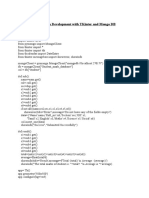0 ratings0% found this document useful (0 votes)
252 viewsPython 4 Info Sec
This document provides an overview of the Python programming language and its uses for security tools and penetration testing. It covers Python basics like variables, strings, lists, and control structures. It also discusses common Python modules like sys, os, and their applications. The document is intended as training material for writing basic security tools using Python.
Uploaded by
kamelancienCopyright
© © All Rights Reserved
Available Formats
Download as PDF, TXT or read online on Scribd
0 ratings0% found this document useful (0 votes)
252 viewsPython 4 Info Sec
This document provides an overview of the Python programming language and its uses for security tools and penetration testing. It covers Python basics like variables, strings, lists, and control structures. It also discusses common Python modules like sys, os, and their applications. The document is intended as training material for writing basic security tools using Python.
Uploaded by
kamelancienCopyright
© © All Rights Reserved
Available Formats
Download as PDF, TXT or read online on Scribd
You are on page 1/ 77
Writing Basic Security
Tools using Python
Ali Al-Shemery
aka B!n@ry, @binaryz0ne
Special thanks to Keith Dixon @Tazdrumm3r
for sharing his work
>>> import antigravity
Cited [2]
Cited
[1]
Ali Al-Shemery, @binaryz0ne 4
Outline
About Python
Python Basics
Types
Controls
Python Functions and Modules
Python Tips and Tricks
Coding for Penetration Testers
4
Ali Al-Shemery, @binaryz0ne 5
About Python
Python is an open source programming
language.
Development started by Guido van Rossum
in December 1989.
Conceived in the late 1980s
Python 2.0 was release on October 16th, 2000
Python 3.0 was released on December 2008
Name came from TV series Monty Pythons
Flying Circus.
Ali Al-Shemery, @binaryz0ne 6
About Python Cont.
Python is cross platform
Linux (shipped out of the box)
Windows (easy to install)
Mac
Even work on your Droid!
etc
Ali Al-Shemery, @binaryz0ne 7
Why Learn Python?
Lot of people always ask me Why learn
Python?
The answer is simple:
Simple and easy to learn
Free and Open Source
Powerful high-level programming language
Widely used (Google, NASA, Yahoo, etc)
Portable
HUGE number of Extensive Libraries!
Ali Al-Shemery, @binaryz0ne 8
What is Python Good for?
Ideal language for scripting and rapid
application development in many areas on
most platforms.
All computer related subjects (IMO except
system programming)
Performing System Administration Tasks
Encouraging and Helping Children start
programming
Ali Al-Shemery, @binaryz0ne 9
What About Security?
Extensive use in the information
security industry
Exploit Development
Networking
Debugging
Encryption/Decription
Reverse Engineering
Fuzzing
Web
Forensics
Malware analysis
Cited [2]
Ali Al-Shemery, @binaryz0ne 10
Lets Start Working
Interactive Interpreter
Text Editors
Vim, Nano,
Geany (my favorite)
Gedit, Kate,
Notepad++, etc
Ali Al-Shemery, @binaryz0ne 11
Python Basics
Integers (int)
>>> httpPort=80
>>> Subnet=24
Floating Point (float)
>>> 5.2/2
2.6
Strings (str)
>>> url=http://www.linuxac.org/
Ali Al-Shemery, @binaryz0ne 12
Playing with Strings
One of the most powerful capabilities of Python
String Slicing
>>> logFile=/var/log/messages
>>> logFile[0]
/
>>> logFile[1:4]
var
>>> logFile[-8:]
'messages'
>>> logFile.split("/")
['', 'var', 'log', 'messages']
Ali Al-Shemery, @binaryz0ne 13
Playing with Strings Cont.
String Concatenation
>>> userName = binary
>>> domainName = linuxac.org
>>> userEmail = userName + @ + domainName
>>> userEmail
binary@linuxac.org
>>> website="http://www.linuxac.org/"
>>> param="?p=123"
>>> url = "".join([website,param])
>>> url
'http://www.linuxac.org/?p=123'
Ali Al-Shemery, @binaryz0ne 14
Python Lists
Python lists are very useful when you have
a collection of elements
>>> portList = [21,22,25,80]
>>> portList[0]
21
>>> portList.append(443)
>>> portList
[21, 22, 25, 80, 443]
>>> portList.remove(22)
>>> portList
[21, 25, 80, 443]
>>> portList.insert(1,22)
>>> portList
[21, 22, 25, 80, 443]
>>> portList = []
>>> portList
[]
Lists in Python can be of
any mixed type, even list of
variables!!!
Ali Al-Shemery, @binaryz0ne 15
Python Controls - Decisions
IF, ELSE, and ELIF Statements
>>> pList = [21,22,25,80]
>>> if pList[0] == 21:
... print("FTP Service")
... elif pList[0] == 22:
... print("SSH Service")
... else:
... print("Unknown Service")
...
FTP
Important NOTE:
Python doesnt use line
terminators (ex:
semicolons), but Python
forces you to use indents
Ensures writing elegant
code!
Ali Al-Shemery, @binaryz0ne 16
Python Controls - Loops
For and While Statements
>>> for port in pList:
... print "This is port : ", port
...
This is port : 21
This is port : 22
This is port : 25
This is port : 80
Ali Al-Shemery, @binaryz0ne 17
Python Tips and Tricks
Changing and checking data types
>>> httpPort=80
>>> httpPort
80
>>> type(httpPort)
<type 'int'>
>>> httpPort = str(httpPort)
>>> type(httpPort)
<type 'str'>
>>> httpPort
'80
Ali Al-Shemery, @binaryz0ne 18
Python Tips and Tricks Cont.
Getting the length of an object
>>> len(pList)
4
String formatting
>>> pList = [21,22,25,80]
>>> for member in pList:
... print "This is port number %d" % member
...
This is port number 21
This is port number 22
This is port number 25
This is port number 80
Ali Al-Shemery, @binaryz0ne 19
Python Tips and Tricks Cont.
Another String formatting example
>>> ip = "192.168.1.1"
>>> mac = "AA:BB:CC:DD:EE:FF"
>>> print "The gateway has the following IP: %s and MAC: %s
addresses" % (ip, mac)
The gateway has the following IP: 192.168.1.1 and MAC:
AA:BB:CC:DD:EE:FF addresses
Ali Al-Shemery, @binaryz0ne 20
Python Tips and Tricks Cont.
Working with ASCII codes
>>> x = '\x41
>>> print x
A
Converting to Hexadecimals
>>> hex(255)
'0xff'
>>> hex(0)
'0x0'
>>> hex(10)
'0xa'
>>> hex(15)
'0xf'
Ali Al-Shemery, @binaryz0ne 21
Python User Input
Python can handle user input from
different sources:
Directly from the user
From Text Files
From GUI (not covered in this training)
Ali Al-Shemery, @binaryz0ne 22
Python User Input Cont.
Directly from the user using raw_input
>>> userEmail = raw_input("Please enter your email
address: ")
Please enter your email address: binary@linuxac.org
>>> userEmail
'binary@linuxac.org'
>>> type(userEmail)
<type 'str'>
Ali Al-Shemery, @binaryz0ne 23
Python User Input Cont.
From Text Files
>>> f = open("./services.txt", "r")
>>> for line in f:
... print line
...
HTTP 80
SSH 22
FTP 21
HTTPS 443
SMTP 25
POP 110
>>> f.close()
Other common file functions:
write
read
readline
Ali Al-Shemery, @binaryz0ne 24
Creating Functions
Whenever you need to repeat a block of code,
functions comes helpful
Creating a Python Function (syntax)
def fName( listOfArguments ):
Line1
Line2
.
Line n
return something
Ali Al-Shemery, @binaryz0ne 25
Creating Functions Cont.
Basic function to check for valid port numbers
def checkPortNumber(port):
if port > 65535 or port < 0:
return False
else:
return True
Howto use the checkPortNumber function:
print checkPortNumber(80) True
print checkPortNumber(66000) False
print checkPortNumber(-1) False
Ali Al-Shemery, @binaryz0ne 26
Working with Modules
Modules in Python are simply any file
containing Python statements!
Python is distributed with many modules
To use a module:
import module
import module1, module2, moduleN
import module as newname
from module import *
from module import <specific>
Ali Al-Shemery, @binaryz0ne 27
Common Used Modules
The most commonly used modules with
security coding are:
string, re
os, sys, socket
hashlib
httplib, urllib2
Others? Please add
Modules and Examples
Ali Al-Shemery, @binaryz0ne 29
Module sys
Check Python path, and count them
import sys
print "path has", len(sys.path), "members
print "The members are:
for member in sys.path:
print member
Print all imported modules:
>>> print sys.modules.keys()
Print the platform type (linux, win32, mac, etc)
>>> print sys.platform
Ali Al-Shemery, @binaryz0ne 30
Module sys Cont.
Check application name, and list number of
passed arguments
import sys
print The application name is:", sys.argv[0]
if len(sys.argv) > 1:
print You passed", len(sys.argv)-1, "arguments. They are:"
for arg in sys.argv[1:]:
print arg
else:
print No arguments passed!
Ali Al-Shemery, @binaryz0ne 31
Module sys Cont.
Check the Python working version
>>> sys.version
Ali Al-Shemery, @binaryz0ne 32
Module os
import os
Check platform name (UNIX/Linux = posix,
Windows = nt):
>>> os.name
Print the current working directory
>>> os.getcwd()
List files in specific directory
fList = os.listdir("/home")
for f in fList:
print f
Ali Al-Shemery, @binaryz0ne 33
Module os Cont.
Remove a file (delete)
>>> os.remove(file.txt")
Check the platform line terminator (Windows =
\r\n , Linux = \n , Mac = \r )
>>> os.linesep
Get the effective UID for current user
>>> os.geteuid()
Check if file and check if directory
>>> os.path.isfile("/tmp")
>>> os.path.isdir("/tmp")
Ali Al-Shemery, @binaryz0ne 34
Module os Cont.
Run a shell command
>>> os.system("ping -c 2 127.0.0.1")
Execute a command & return a file object
files = os.popen("ls -l /tmp")
for i in files:
print i
Ali Al-Shemery, @binaryz0ne 35
Module os Cont.
os.system() # Executing a shell command
os.stat() # Get the status of a file
os.environ() # Get the users environment
os.chdir() # Move focus to a different directory
os.getcwd() # Returns the current working directory
os.getgid() # Return the real group id of the current process
os.getuid() # Return the current processs user id
os.getpid() # Returns the real process ID of the current process
os.getlogin() # Return the name of the user logged
os.access() # Check read permissions
os.chmod() # Change the mode of path to the numeric mode
os.chown() # Change the owner and group id
os.umask(mask) # Set the current numeric umask
os.getsize() # Get the size of a file
Ali Al-Shemery, @binaryz0ne 36
Module os Cont.
os.path.getmtime() # Last time a given directory was modified
os.path.getatime() # Last time a given directory was accessed
os.environ() # Get the users environment
os.uname() # Return information about the current OS
os.chroot(path) # Change the root directory of the current process
to path
os.listdir(path) # List of the entries in the directory given by path
os.getloadavg() # Show queue averaged over the last 1, 5, and 15
minutes
os.path.exists() # Check if a path exists
os.walk() # Print out all directories, sub-directories and files
Ali Al-Shemery, @binaryz0ne 37
Module os Cont.
os.mkdir(path) # Create a directory named path with
numeric mode mode
os.makedirs(path) # Recursive directory creation function
os.remove(path) # Remove (delete) the file path
os.removedirs(path) # Remove directories recursively
os.rename(src, dst) # Rename the file or directory src to dst
os.rmdir(path) # Remove (delete) the directory path
Ali Al-Shemery, @binaryz0ne 38
Module socket
import socket
Creating a simple TCP client
Check simpleClient.py
Creating a simple TCP server
Check simpleServer.py
Create a malicious FTP Client
ftpClient.py
Ali Al-Shemery, @binaryz0ne 39
Module socket Cont.
Create TCP Socket, then send and receive data
from website using the socket
import socket
s = socket.socket(socket.AF_INET, socket.SOCK_STREAM)
s.connect(("www.linuxac.org", 80))
s.send('GET / HTTP/1.1\r\nHost: www.linuxac.org\r\n\r\n')
data = s.recv(2048)
s.close()
print data
Note: For UDP Sockets use SOCK_DGRAM
instead of SOCK_STREAM
Ali Al-Shemery, @binaryz0ne 40
Module pcapy
Pcapy is a Python extension module that interfaces
with the libpcap packet capture library.
Pcapy enables python scripts to capture packets
on the network.
Pcapy is highly effective when used in conjunction
with a packet-handling package such as Impacket,
which is a collection of Python classes for
constructing and dissecting network packets.
Packet Capturing using pcapy example
pcapyPktCapture1.py
pcapyEx1.py
pcapyDumper.py
Ali Al-Shemery, @binaryz0ne 41
Module urllib & urllib2
urllib2 is a Python module for fetching URLs.
Offers a very simple interface, in the form of the
urlopen function.
Capable of fetching URLs using a variety of
different protocols (http, ftp, file, etc)
Also offers a slightly more complex interface for
handling common situations:
Basic authentication
Cookies
Proxies
etc
Ali Al-Shemery, @binaryz0ne 42
urllib vs urllib2
Both modules do URL request related stuff, but
they have different functionality.
urllib2 can accept a Request object to set the
headers for a URL request, urllib accepts only a
URL.
urllib provides the urlencode method which is
used for the generation of GET query strings,
urllib2 doesn't have such a function.
Because of that urllib and urllib2 are often used
together.
Cited [3]
Ali Al-Shemery, @binaryz0ne 43
Example1
import urllib2
request = urllib2.Request('http://www.linuxac.org')
response = urllib2.urlopen(request)
payload = response.read()
print(payload)
Cited [3]
Ali Al-Shemery, @binaryz0ne 44
Basic URL Request
import urllib2
response =
urllib2.urlopen('http://pythonforbeginners.com/')
print response.info()
html = response.read()
response.close()
Cited [3]
Ali Al-Shemery, @binaryz0ne 45
Base64 & ROT13 Encoders
Base64
#!/usr/bin/python
code = raw_input("Enter the data you wish to be encoded to
Base64")
answer=code.encode('base64','strict')
print answer
ROT13
#!/usr/bin/python
code = raw_input("Enter the data you wish to be encoded to
Base64")
answer=code.encode(rot13','strict')
print answer
Cited [2]
Ali Al-Shemery, @binaryz0ne 46
Exploit Development
#!/usr/bin/python
import socket
host = target
port = <port#>
cmd = initial command
s = socket.socket(socket.AF_INET, socket.SOCK_STREAM)
buffer = buffer to send
shellcode = shellcode
Payload = cmd + buffer + shellcode
print "\n Any status message \n
s.connect((host,port))
data = s.recv(1024)
s.send(payload +\n)
s.close
Packet Crafting with Scapy
Ali Al-Shemery, @binaryz0ne 48
Scapy Overview
Scapy is a Python program that enables the
user to send, sniff and dissect and forge
network packets.
This capability allows construction of tools
that can probe, scan or attack networks.
It can replace hping, arpspoof, arp-sk, arping,
p0f and even some parts of Nmap, tcpdump,
and tshark.
Ali Al-Shemery, @binaryz0ne 49
Scapy Overview Cont.
Scapy was created by Philippe Biondi and runs
in Python:
Can be used interactively at a Python prompt
Included within Python scripts for more
complex interactions
Must run with root privileges to craft packets,
Dont need to be a Python Guru to use Scapy!
Ali Al-Shemery, @binaryz0ne 50
Scapy Basics - 1
Supported protocols:
>>> ls()
Details about a specific protocol:
>>> ls(TCP)
Available commands/functions:
>>> lsc()
Ali Al-Shemery, @binaryz0ne 51
Scapy Basics - 2
Crafting a SYN/ACK Packet
>>> pkt = IP(dst="192.168.122.101")
>>> pkt /= TCP(dport=80, flags="SA")
Crafting ICMP Host Unreachable Packet
>>> pkt = IP(dst="192.168.122.101")
>>> pkt /= ICMP(type=3,code=1)
Ali Al-Shemery, @binaryz0ne 52
Scapy Basics - 3
Single Line:
ICMP echo request Packet
>>> mypkt = IP(dst="192.168.122.101")
/ICMP(code=0,type=8)
TCP FIN, Port 22, Random Source Port, and
Random Seq#
>>> mypkt = IP(dst="192.168.122.101")
/TCP(dport=22,sport=RandShort(),seq=RandShort(
),flags="F")
Ali Al-Shemery, @binaryz0ne 53
Sending and Receiving Packets
@L3
Send packet at layer 3
>>> send(packet)
Send packet at L3 and receive one response
>>> resp = sr1(packet)
Send packet at L3 and receive all responses
>>> ans,unans = sr(packet)
Ali Al-Shemery, @binaryz0ne 54
Sending and Receiving Packets
@L2
Send packet at layer 2
>>> sendp(Ether()/packet)
Send packet at L2 and receive one response
>>> resp = srp1(packet)
Send packet at L2 and receive all responses
>>> ans,unans = srp(packet)
Ali Al-Shemery, @binaryz0ne 55
Displaying Packets
Get a summary of each packet:
>>> pkts.summary()
Get the whole packet list:
>>> pkts.show()
Ali Al-Shemery, @binaryz0ne 56
Scapy Host Discovery
>>> ans,unans =
srp(Ether(dst="ff:ff:ff:ff:ff:ff")/ARP(pdst="192.168.1
22.0/24"),timeout=2)
>>> ans.summary(lambda(s,r): r.sprintf("Ether:
%Ether.src% \t\t Host: %ARP.psrc%"))
Ali Al-Shemery, @binaryz0ne 57
Scapy Port Scanning
TCP SYN Scanner
>>> sr1(IP(dst="192.168.122.101")
/TCP(dport=90,flags="S"))
>>> a,u = sr(IP(dst="192.168.122.101")
/TCP(dport=(80,100),flags="S"))
>>> a.summary(lambda(s,r): r.sprintf("Port:
%TCP.sport% \t\t Flags: %TCP.flags%"))
Ali Al-Shemery, @binaryz0ne 58
Scapy Sniffing - 1
Scapy has powerful capabilities to capture and
analyze packets.
Configure the network interface to sniff
packets from:
>>> conf.iface="eth0
Configure the scapy sniffer to sniff only 20 packets
>>> pkts=sniff(count=20)
Ali Al-Shemery, @binaryz0ne 59
Scapy Sniffing - 2
Sniff packets and stop after a defined time:
>>> pkts=sniff(count=100,timeout=60)
Sniff only packets based on a filter:
>>> pkts = sniff(count=100,filter="tcp port 80")
Ali Al-Shemery, @binaryz0ne 60
Scapy Sniffing - 3
>>> pkts = sniff(count=10,prn=lambda
x:x.sprintf("SrcIP={IP:%IP.src% ->
DestIP=%IP.dst%} |
Payload={Raw:%Raw.load%\n}"))
What is that doing ???
Ali Al-Shemery, @binaryz0ne 61
Exporting Packets
Sometimes it is very useful to save the captured
packets in a PCAP file for future work:
>>> wrpcap(file1.cap", pkts)
Dumping packets in HEX format:
>>> hexdump(pkts)
Dump a single packet in HEX format:
>>> hexdump(pkts[2])
Convert a packet to hex string:
>>> str(pkts[2])
Exporting to Base64 encoded packets:
>>> export_object(pkts)
Ali Al-Shemery, @binaryz0ne 62
Importing Packets
To import from a PCAP file:
>>> pkts = rdpcap(file1.cap")
Or use the scapy sniffer but with the offline
argument:
>>> pkts2 = sniff(offline="file1.cap")
Ali Al-Shemery, @binaryz0ne 63
Create your own tools
>>> def handler(packet):
hexdump(packet.payload)
>>> sniff(count=20, prn=handler)
>>> def handler2(packet):
sendp(packet)
>>> sniff(count=20, prn=handler2)
Python Tools for
Penetration Testers
Ali Al-Shemery, @binaryz0ne 65
Network Tools
Scapy: send, sniff and dissect and forge network packets. Usable interactively or as a
library
pypcap, Pcapy and pylibpcap: several different Python bindings for libpcap
libdnet: low-level networking routines, including interface lookup and Ethernet frame
transmission
dpkt: fast, simple packet creation/parsing, with definitions for the basic TCP/IP protocols
Impacket: craft and decode network packets. Includes support for higher-level protocols
such as NMB and SMB
pynids: libnids wrapper offering sniffing, IP defragmentation, TCP stream reassembly and
port scan detection
Dirtbags py-pcap: read pcap files without libpcap
flowgrep: grep through packet payloads using regular expressions
Knock Subdomain Scan, enumerate subdomains on a target domain through a wordlist
Mallory, extensible TCP/UDP man-in-the-middle proxy, supports modifying non-standard
protocols on the fly
Pytbull: flexible IDS/IPS testing framework (shipped with more than 300 tests)
Cited [5]
Ali Al-Shemery, @binaryz0ne 66
Debugging and Reverse
Engineering Tools
Paimei: reverse engineering framework, includes PyDBG, PIDA, pGRAPH
Immunity Debugger: scriptable GUI and command line debugger
mona.py: PyCommand for Immunity Debugger that replaces and improves on
pvefindaddr
IDAPython: IDA Pro plugin that integrates the Python programming language,
allowing scripts to run in IDA Pro
PyEMU: fully scriptable IA-32 emulator, useful for malware analysis
pefile: read and work with Portable Executable (aka PE) files
pydasm: Python interface to the libdasm x86 disassembling library
PyDbgEng: Python wrapper for the Microsoft Windows Debugging Engine
uhooker: intercept calls to API calls inside DLLs, and also arbitrary addresses within
the executable file in memory
diStorm: disassembler library for AMD64, licensed under the BSD license
python-ptrace: debugger using ptrace (Linux, BSD and Darwin system call to trace
processes) written in Python
vdb / vtrace: vtrace is a cross-platform process debugging API implemented in
python, and vdb is a debugger which uses it
Androguard: reverse engineering and analysis of Android applications
Cited [5]
Ali Al-Shemery, @binaryz0ne 67
Fuzzing Tools
Sulley: fuzzer development and fuzz testing framework consisting of multiple extensible components
Peach Fuzzing Platform: extensible fuzzing framework for generation and mutation based fuzzing (v2
was written in Python)
antiparser: fuzz testing and fault injection API
TAOF, (The Art of Fuzzing) including ProxyFuzz, a man-in-the-middle non-deterministic network fuzzer
untidy: general purpose XML fuzzer
Powerfuzzer: highly automated and fully customizable web fuzzer (HTTP protocol based application
fuzzer)
SMUDGE
Mistress: probe file formats on the fly and protocols with malformed data, based on pre-defined patterns
Fuzzbox: multi-codec media fuzzer
Forensic Fuzzing Tools: generate fuzzed files, fuzzed file systems, and file systems containing fuzzed
files in order to test the robustness of forensics tools and examination systems
Windows IPC Fuzzing Tools: tools used to fuzz applications that use Windows Interprocess
Communication mechanisms
WSBang: perform automated security testing of SOAP based web services
Construct: library for parsing and building of data structures (binary or textual). Define your data
structures in a declarative manner
fuzzer.py (feliam): simple fuzzer by Felipe Andres Manzano
Fusil: Python library used to write fuzzing programs
Cited [5]
Ali Al-Shemery, @binaryz0ne 68
Web Tools
Requests: elegant and simple HTTP library, built for human beings
HTTPie: human-friendly cURL-like command line HTTP client
ProxMon: processes proxy logs and reports discovered issues
WSMap: find web service endpoints and discovery files
Twill: browse the Web from a command-line interface. Supports automated Web
testing
Ghost.py: webkit web client written in Python
Windmill: web testing tool designed to let you painlessly automate and debug your
web application
FunkLoad: functional and load web tester
spynner: Programmatic web browsing module for Python with Javascript/AJAX
support
python-spidermonkey: bridge to the Mozilla SpiderMonkey JavaScript engine; allows
for the evaluation and calling of Javascript scripts and functions
mitmproxy: SSL-capable, intercepting HTTP proxy. Console interface allows traffic
flows to be inspected and edited on the fly
pathod / pathoc: pathological daemon/client for tormenting HTTP clients and servers
Cited [5]
Ali Al-Shemery, @binaryz0ne 69
Forensic Tools
Volatility: extract digital artifacts from volatile memory (RAM) samples
LibForensics: library for developing digital forensics applications
TrIDLib, identify file types from their binary signatures. Now includes Python binding
aft: Android forensic toolkit
Cited [5]
Ali Al-Shemery, @binaryz0ne 70
Malware Analysis Tools
pyew: command line hexadecimal editor and disassembler, mainly to analyze
malware
Exefilter: filter file formats in e-mails, web pages or files. Detects many common file
formats and can remove active content
pyClamAV: add virus detection capabilities to your Python software
jsunpack-n, generic JavaScript unpacker: emulates browser functionality to detect
exploits that target browser and browser plug-in vulnerabilities
yara-python: identify and classify malware samples
phoneyc: pure Python honeyclient implementation
Cited [5]
Ali Al-Shemery, @binaryz0ne 71
PDF Tools
Didier Stevens' PDF tools: analyse, identify and create PDF files (includes PDFiD,
pdf-parser and make-pdf and mPDF)
Opaf: Open PDF Analysis Framework. Converts PDF to an XML tree that can be
analyzed and modified.
Origapy: Python wrapper for the Origami Ruby module which sanitizes PDF files
pyPDF: pure Python PDF toolkit: extract info, spilt, merge, crop, encrypt, decrypt...
PDFMiner: extract text from PDF files
python-poppler-qt4: Python binding for the Poppler PDF library, including Qt4
support
Cited [5]
Lab Time!
Ali Al-Shemery, @binaryz0ne 73
DIY
This lab is a Do It Yourself (DIY) Lab that must
done at home:
[1] Create a TCP ACK Port Scanner
[2] Create a TCP Replay Tool
[3] Create a UDP Ping Tool
[4] Create a Sniffer that filters based on user
input
[5] Create a tool for HTTP Basic Authentication
over
[6] Create a basic Honeypot that logs all activity
to a text file
Ali Al-Shemery, @binaryz0ne 74
SUMMARY
Discussed Why Learn Python
Discussed What is Python Good for?
Explained Python Basics:
Integers, Floating point, etc
Strings,
Lists,
Controls,
etc
Some Quick Python Tips and Tricks
Python User Input
Howto Create Functions using Python
Working with Modules, and the Python Common
Used Modules
Ali Al-Shemery, @binaryz0ne 75
SUMMARY Cont.
Howto use the Python SYS and OS Modules
Using Python to work with Networks: Sockets,
pcapy, etc
Using Python to work with the Web (urllib, urllib2)
Using Python to create simple Encoders
Howto use Python for Exploit Development
Craft your own packets using Scapy
Python tools for penetration testers
DIY Labs
Ali Al-Shemery, @binaryz0ne 76
Works Cited
[1] Python Comic, http://xkcd.com/353/,
[2] Keith Dixon, @Tazdrumm3r,
http://tazdrumm3r.wordpress.com/
[3] Live Packet Capture in Python with pcapy,
http://snipplr.com/view/3579/live-packet-capture-in-
python-with-pcapy/
[4] How to use urllib2 in Python,
http://www.pythonforbeginners.com/python-on-the-
web/how-to-use-urllib2-in-python/
[5] Python tools for penetration testers, http://www.dirk-
loss.de/python-tools.htm
Ali Al-Shemery, @binaryz0ne 77
References
[1] Coding for Penetration Testers Book,
[2] Violent Python Book,
[3] Scapy Documentation, http://www.secdev.org/projects/scapy/doc/
[4] Python, http://www.python.org/
[5] Python Infosec tools, http://www.dirk-loss.de/python-tools.htm
[6] Grow Your Own Forensic Tools: A Taxonomy of Python Libraries Helpful for
Forensic Analysis,
http://www.sans.org/reading_room/whitepapers/incident/grow-forensic-
tools-taxonomy-python-libraries-helpful-forensic-analysis_33453
[7] Python Docs, http://docs.python.org/
[8] Python Tutorial, http://www.tutorialspoint.com/python/index.htm
[9] pcapy,
http://corelabs.coresecurity.com/index.php?module=Wiki&action=view&typ
e=tool&name=Pcapy
[10] Basic Authentication Authentication with Python,
http://www.voidspace.org.uk/python/articles/authentication.shtml
[11] Justin Searle, Python Basics for Web App Pentesters, InGuardians Inc
You might also like
- Javascript Algorithms Sample Chapter Your First AlgorithmsNo ratings yetJavascript Algorithms Sample Chapter Your First Algorithms38 pages
- Python Advanced Programming: The Guide to Learn Python Programming. Reference with Exercises and Samples About Dynamical Programming, Multithreading, Multiprocessing, Debugging, Testing and MoreFrom EverandPython Advanced Programming: The Guide to Learn Python Programming. Reference with Exercises and Samples About Dynamical Programming, Multithreading, Multiprocessing, Debugging, Testing and MoreNo ratings yet
- Api-Demo: Platform-As-A-Service (Paas) Based SolutionNo ratings yetApi-Demo: Platform-As-A-Service (Paas) Based Solution6 pages
- Introduction To Computer Programming Using Python Comp 111No ratings yetIntroduction To Computer Programming Using Python Comp 111227 pages
- Python For Reverse Engineering and Malware Analysis100% (1)Python For Reverse Engineering and Malware Analysis3 pages
- Building Rest Apis With Flask: Create Python Web Services With MysqlNo ratings yetBuilding Rest Apis With Flask: Create Python Web Services With Mysql10 pages
- Python Keywords, Identifiers and Variables - FundamentalsNo ratings yetPython Keywords, Identifiers and Variables - Fundamentals179 pages
- A Python Book - Beginning Python, Advanced Python, & Python Exercises PDFNo ratings yetA Python Book - Beginning Python, Advanced Python, & Python Exercises PDF227 pages
- Setting Up A Simple OCR Server: by Real Python 37 CommentsNo ratings yetSetting Up A Simple OCR Server: by Real Python 37 Comments8 pages
- Download Complete Python Penetration Testing Essentials Techniques for ethical hacking with Python 2nd Edition Mohit PDF for All Chapters100% (4)Download Complete Python Penetration Testing Essentials Techniques for ethical hacking with Python 2nd Edition Mohit PDF for All Chapters40 pages
- T.R. Padmanabhan-Programming With Python-Springer (2016)100% (1)T.R. Padmanabhan-Programming With Python-Springer (2016)345 pages
- Python Console Application Development 2No ratings yetPython Console Application Development 227 pages
- Beginners Tutorial For Regular Expressions in Python - Python LearningNo ratings yetBeginners Tutorial For Regular Expressions in Python - Python Learning23 pages
- Python 5 Manuscripts - Python For Beginners, Python Programming, Hacking With Python, Tor, Bitcoin100% (8)Python 5 Manuscripts - Python For Beginners, Python Programming, Hacking With Python, Tor, Bitcoin620 pages
- Practice Python Questions and Challenges For Beginners100% (1)Practice Python Questions and Challenges For Beginners221 pages
- Application Development With Tkinter and Mongo DB: CodeNo ratings yetApplication Development With Tkinter and Mongo DB: Code3 pages
- Python - Basic and Intermediate Level ModulesNo ratings yetPython - Basic and Intermediate Level Modules338 pages
- Siahaan V. Data Science Crash Course... With Python GUI 2ed 2023No ratings yetSiahaan V. Data Science Crash Course... With Python GUI 2ed 2023610 pages
- Python For Networking, Security and F5 AdministratorsNo ratings yetPython For Networking, Security and F5 Administrators4 pages
- Mastering C++ Network Automation: Run Automation across Configuration Management, Container Orchestration, Kubernetes, and Cloud NetworkingFrom EverandMastering C++ Network Automation: Run Automation across Configuration Management, Container Orchestration, Kubernetes, and Cloud NetworkingNo ratings yet
- Vstep Writing Test 1 Levels 3-5: Banking University of Ho Chi Minh Center For F Oreign Languages and Applied InformaticsNo ratings yetVstep Writing Test 1 Levels 3-5: Banking University of Ho Chi Minh Center For F Oreign Languages and Applied Informatics5 pages
- Mga Sikolohikal Na Salik Sa Pagkatuto NG PangalawangNo ratings yetMga Sikolohikal Na Salik Sa Pagkatuto NG Pangalawang13 pages
- HC Verma Solutions Class 11 Chapter 2 - Physics and MathematicsNo ratings yetHC Verma Solutions Class 11 Chapter 2 - Physics and Mathematics6 pages
- Project Management Planning and Scheduling Techniques 1st edition by Vijay Bansal ISBN 9781032549378 - Own the ebook now with all fully detailed content100% (19)Project Management Planning and Scheduling Techniques 1st edition by Vijay Bansal ISBN 9781032549378 - Own the ebook now with all fully detailed content70 pages
- Identity, Language Learning, and Social ChangeNo ratings yetIdentity, Language Learning, and Social Change37 pages
- Beauty Care (Nail Care) Services: Technology and Livelihood Education100% (1)Beauty Care (Nail Care) Services: Technology and Livelihood Education22 pages
- Reflection On Language Culture and Translation andNo ratings yetReflection On Language Culture and Translation and7 pages
- IEEE 754: An Interview With William Kahan: CS: WKNo ratings yetIEEE 754: An Interview With William Kahan: CS: WK2 pages
- Instructional Strategies To Support Creativity and Innovation in EducationNo ratings yetInstructional Strategies To Support Creativity and Innovation in Education8 pages
- Language Curriculum For Secondary Schools Course Outline100% (2)Language Curriculum For Secondary Schools Course Outline3 pages
- Developing Your Intuition Develop Clairvoyance0% (2)Developing Your Intuition Develop Clairvoyance2 pages
- Individual Performance Profile RN Safety: Preventing Medication Errors 3.0 Case Study TestNo ratings yetIndividual Performance Profile RN Safety: Preventing Medication Errors 3.0 Case Study Test3 pages
- Paragraph Writing - Autumn Exam Second Sitting - 240102 - 191819No ratings yetParagraph Writing - Autumn Exam Second Sitting - 240102 - 1918192 pages
- THE EFFECTIVENESS OF DIFFERENTIATED INSTRUCTION ON THE LEARNING PERFORMANCE IN MATHEMATICS AMONG GRADE FOUR STUDENTS Ijariie18958No ratings yetTHE EFFECTIVENESS OF DIFFERENTIATED INSTRUCTION ON THE LEARNING PERFORMANCE IN MATHEMATICS AMONG GRADE FOUR STUDENTS Ijariie1895813 pages
- Einstein Triangles 1: Critical Thinking Cartoons and Paintings100% (4)Einstein Triangles 1: Critical Thinking Cartoons and Paintings395 pages
- Javascript Algorithms Sample Chapter Your First AlgorithmsJavascript Algorithms Sample Chapter Your First Algorithms
- Python Advanced Programming: The Guide to Learn Python Programming. Reference with Exercises and Samples About Dynamical Programming, Multithreading, Multiprocessing, Debugging, Testing and MoreFrom EverandPython Advanced Programming: The Guide to Learn Python Programming. Reference with Exercises and Samples About Dynamical Programming, Multithreading, Multiprocessing, Debugging, Testing and More
- Api-Demo: Platform-As-A-Service (Paas) Based SolutionApi-Demo: Platform-As-A-Service (Paas) Based Solution
- Introduction To Computer Programming Using Python Comp 111Introduction To Computer Programming Using Python Comp 111
- Python For Reverse Engineering and Malware AnalysisPython For Reverse Engineering and Malware Analysis
- Building Rest Apis With Flask: Create Python Web Services With MysqlBuilding Rest Apis With Flask: Create Python Web Services With Mysql
- Python Keywords, Identifiers and Variables - FundamentalsPython Keywords, Identifiers and Variables - Fundamentals
- A Python Book - Beginning Python, Advanced Python, & Python Exercises PDFA Python Book - Beginning Python, Advanced Python, & Python Exercises PDF
- Setting Up A Simple OCR Server: by Real Python 37 CommentsSetting Up A Simple OCR Server: by Real Python 37 Comments
- Download Complete Python Penetration Testing Essentials Techniques for ethical hacking with Python 2nd Edition Mohit PDF for All ChaptersDownload Complete Python Penetration Testing Essentials Techniques for ethical hacking with Python 2nd Edition Mohit PDF for All Chapters
- T.R. Padmanabhan-Programming With Python-Springer (2016)T.R. Padmanabhan-Programming With Python-Springer (2016)
- Beginners Tutorial For Regular Expressions in Python - Python LearningBeginners Tutorial For Regular Expressions in Python - Python Learning
- Python 5 Manuscripts - Python For Beginners, Python Programming, Hacking With Python, Tor, BitcoinPython 5 Manuscripts - Python For Beginners, Python Programming, Hacking With Python, Tor, Bitcoin
- Practice Python Questions and Challenges For BeginnersPractice Python Questions and Challenges For Beginners
- Application Development With Tkinter and Mongo DB: CodeApplication Development With Tkinter and Mongo DB: Code
- Siahaan V. Data Science Crash Course... With Python GUI 2ed 2023Siahaan V. Data Science Crash Course... With Python GUI 2ed 2023
- Python For Networking, Security and F5 AdministratorsPython For Networking, Security and F5 Administrators
- Python Unleashed: Mastering the Art of Efficient CodingFrom EverandPython Unleashed: Mastering the Art of Efficient Coding
- 50 Python Concepts Every Developer Should KnowFrom Everand50 Python Concepts Every Developer Should Know
- Mastering C++ Network Automation: Run Automation across Configuration Management, Container Orchestration, Kubernetes, and Cloud NetworkingFrom EverandMastering C++ Network Automation: Run Automation across Configuration Management, Container Orchestration, Kubernetes, and Cloud Networking
- Vstep Writing Test 1 Levels 3-5: Banking University of Ho Chi Minh Center For F Oreign Languages and Applied InformaticsVstep Writing Test 1 Levels 3-5: Banking University of Ho Chi Minh Center For F Oreign Languages and Applied Informatics
- Mga Sikolohikal Na Salik Sa Pagkatuto NG PangalawangMga Sikolohikal Na Salik Sa Pagkatuto NG Pangalawang
- HC Verma Solutions Class 11 Chapter 2 - Physics and MathematicsHC Verma Solutions Class 11 Chapter 2 - Physics and Mathematics
- Project Management Planning and Scheduling Techniques 1st edition by Vijay Bansal ISBN 9781032549378 - Own the ebook now with all fully detailed contentProject Management Planning and Scheduling Techniques 1st edition by Vijay Bansal ISBN 9781032549378 - Own the ebook now with all fully detailed content
- Beauty Care (Nail Care) Services: Technology and Livelihood EducationBeauty Care (Nail Care) Services: Technology and Livelihood Education
- Reflection On Language Culture and Translation andReflection On Language Culture and Translation and
- Instructional Strategies To Support Creativity and Innovation in EducationInstructional Strategies To Support Creativity and Innovation in Education
- Language Curriculum For Secondary Schools Course OutlineLanguage Curriculum For Secondary Schools Course Outline
- Individual Performance Profile RN Safety: Preventing Medication Errors 3.0 Case Study TestIndividual Performance Profile RN Safety: Preventing Medication Errors 3.0 Case Study Test
- Paragraph Writing - Autumn Exam Second Sitting - 240102 - 191819Paragraph Writing - Autumn Exam Second Sitting - 240102 - 191819
- THE EFFECTIVENESS OF DIFFERENTIATED INSTRUCTION ON THE LEARNING PERFORMANCE IN MATHEMATICS AMONG GRADE FOUR STUDENTS Ijariie18958THE EFFECTIVENESS OF DIFFERENTIATED INSTRUCTION ON THE LEARNING PERFORMANCE IN MATHEMATICS AMONG GRADE FOUR STUDENTS Ijariie18958
- Einstein Triangles 1: Critical Thinking Cartoons and PaintingsEinstein Triangles 1: Critical Thinking Cartoons and Paintings

























































































